
The research group of Prof. Okamoto in Department of Photo-Molecular Science, IMS (Dr. Y. Jiang, Dr. T. Narushima, and Prof. H. Okamoto) found a novel phenomenon of optical tweezers by the use of ultrashort laser pulses. In the new optical tweezers, two nanoparticles can be trapped separately at both sides of the focal point of the laser beam, and the separation between them can be adjusted in nanometer level.
When a laser beam is focused, small particles nearby the focus are attracted to the focal point. This phenomenon is called "optical (or laser) tweezers" and is utilized in the field of nano- and micro-machining, biological researches, and so forth. In conventional optical tweezers, the particles are trapped at the center of the focal point of the laser beam (Fig. 1).
Okamoto group has found this time that the use of intense ultrashort (ca. 100 fs) pulses as the incident laser beam makes the trapping site split into two (Fig. 2). By this method two particles are trapped separately at the same time with a controlled distance between the two. They have found that the separation between the two trapped particles can be adjusted in tens to hundreds nanometers scale by changing the laser intensity. The direction of the particle alignment can be also varied by rotating the incident laser polarization. After analysis of the trapping behavior, it has turned out that this novel phenomenon is arising from optical nonlinear behavior of the trapped particles. Such a nonlinear behavior becomes prominent only when the material is irradiated by intense light that is achievable in ultrashort pulses.

Fig. 1. A gold nanoparticle trapped by conventional optical tweezers. The particle is trapped at the center of the laser focus.

Fig. 2. Two gold nanoparticles trapped by nonlinear optical tweezers using ultrashort pulses. Two particles are trapped separately and aligned along the incident laser polarization (arrows). The white line in lower right of each panel corresponds 3 micrometers.
Paper Information
Journal: Nature Physics 6, 1005–1009 (2010)
Title: Nonlinear optical effects in trapping nanoparticles with femtosecond pulses
Authors: Yuqiang Jiang, Tetsuya Narushima, Hiromi Okamoto
OKAMOTO Group
http://www.ims.ac.jp/english/know_en/photo/okamoto/okamoto_en.html
1108


